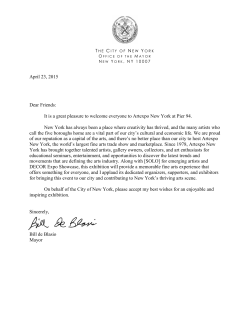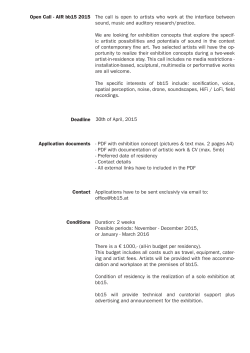
Spatial Stories: Topographies of Change in Africa
Contact: Cecily Cullen, Creative Director conleycu@msudenver.edu, 303.294.5207, x113 Spatial Stories: Topographies of Change in Africa February 6 – April 4, 2015 Metropolitan State University of Denver, Center for Visual Art proudly presents the exhibition Spatial Stories: Topographies of Change in Africa, on view February 6 – April 4, 2015. “Every story is a travel story – a spatial practice… In reality, they organize walks. They make the journey, before or during the time the feet perform it.” -- Michel de Certeau Spatial Stories addresses evolution of the figurative and literal landscape of Africa, played out through social, political and physical change. Contemporary, photo-based work that is atypical of the photojournalistic images often seen in the West, provides glimpses of how the reality of transformation unfolds through the lens of those that “make the journey.” The exhibition explores the notion of place and uncovers transformation triggered by various factors such as technology, globalization, and changing perspectives, for better or worse. The title, Spatial Stories, comes from the writing of Michel de Certeau. In his book, The Practice of Everyday Life De Certeau discusses the concepts of strategies and tactics. De Certeau asserts that corporations, governments, cartographers and those in power practice strategies when they create cities; abstract ideas that do not correspond to the practices of those who walk the cities. The walkers make selections, actualizing the possibilities and the interdictions of cities. Walkers appropriate the topographical system. For this exhibition, we utilized both the notion of strategies in relationship to the continent of Africa, a continent which has been created by corporations, governments, and colonized via maps; and the artists as narrators that subvert this abstract, totalizing image of Africa. With artists hailing from Algeria, the Democratic Republic of Congo, Kenya, Mozambique, South Africa, and Tunisia, each of these artists represents a different narrative of Africa, one that is uniquely their own and free of strategies. Spatial Stories does not attempt to provide a conclusive or comprehensive statement about the state of change on the continent, but rather dives deep with these artists to explore through their individual experience. Curated by Leila Armstrong, MSU Denver visiting faculty in Art History, Theory and Criticism; Cecily Cullen, CVA creative director; and Susanne Mitchell, Visiting Artist in Residence at Greatmore Studios, Cape Town, South Africa. Participating artists include: Ismail Bahri – b. 1978, Tunisia Bahri’s video work Orientations is filmed by a subjective camera that recounts a wandering stroll in the city of Tunis. The off-screen reflected in a glass filled with ink is used as a compass and an illusory float with a funambulistic progression. In this very simple optical device, the appearance of city fragments gives directions and stretches the horizon. This video installation shows a walk of short-sightedness and a gathering of images of the overflowing and distraction of senses. Sammy Baloji – b. 1978, Lubumbashi, Democratic Republic of Congo Baloji’s photography explores ethnography, architecture, and urbanism. He looks at the Congolese past as a way of analyzing African identity today. That identity can be connoted through the occupation of space, how the environment is exploited, or through evident signs of a civilization that was built before, during, and after colonization, moving into the current era of globalization. Dineo Seshee Bopape – b. 1981, Polokwane, South Africa. Bopape attended the Durban Institute of Technology and received her MFA at Columbia University where she studied with Kara Walker and was a recipient of the 2010 Columbia University Toby Fund Award. Her video works focus on the ideas of memory, time, space, narration, trauma, displacement, and nonsense. Bruno Hadjih – b. 1954, Algeria Hadji’s photographic series, Terra Incognita reveals the Sahara Desert as a “living desert.” In contrast to the romanticized visions of the Sahara as being somehow exempt from modernity and human impact, Hadji shows his viewer the encroaching hand of man, a place where human ventures are reconciled with natural elements. Pieter Hugo – b. 1976, Johannesburg, South Africa Hugo’s photographs from the series Permanent Error shed light on the massive wasteland of discarded electronics in Ghana. Here transformation of the landscape, along with technological progress, takes a backward turn and imposes detrimental effects on environmental and human health. Mario Macilau – b. 1984 Maputo, Mozanbique Macilau started his journey as photographer in 2003 and went professional when he traded his mother's cell phone for his first camera in 2007. He specializes in long term projects that focus on the living and environmental conditions affecting isolated groups over time. Santu Mofokeng – b. 1956, Johannesburg, South Africa In his photographs of billboards in urban landscapes, Mofokeng goes beyond political and social commentary into meditations on “the absurdities of living”. Noting that “billboards have been the medium of communication between the rulers and the denizens of townships since the beginning of the township”, in his images their solicitations cruelly highlight the impoverishment of the citizenry they importune. th Mofokeng has been the recipient of numerous awards and participated in the 55 Venice Biennale. Mikhael Subotzky – b. 1981, Cape Town, South Africa Mikhael Subotzky’s photographic works are concerned with the structures of narrative and representation, as well as the relationship between social storytelling and the formal contingencies of image making. Subotzky’s Ponte City series emulates the iconic 54-story Ponte City building built in 1976 Johannesburg. The building towered over the city and at different times symbolized hope and alternately the city’s decline, taking on its own mythology in relationship to the cyclical character of city. Mwangi Hutter – Ingrid Mwangi: b. 1975, Nairobi, Kenya. Robert Hutter: b. 1964, Ludwigshafen, Germany Mwangi Hutter’s artwork addresses universal human experience, using themselves and their diverse surroundings as the sounding board for creating an aesthetics of self-knowledge and relation. The work Single Entities, a three-channel video installation features costumes influenced by places of business in Ouakam, Dakar. The full body clothing represents the merging of a person with their surroundings. Wangechi Mutu- b. 1972, Nairobi, Kenya Mutu addresses perceptions of conflicting cultural projections played out on the body through her contemplations on race and gender. The work aims towards a deeper exploration and disclosure of the artist's own experience in the Diaspora. Ideas around longing, memory, and exile resonate and subvert traditional notions of a singular place of origin. Fusing her Kenyan experience with inflections of other cultural influences, the work calls into question any notion of a static identity and firmly rejects the centralization and dominance of Eurocentric constructs within and outside of her homeland. Guy Tillim – b. 1962, Johannesburg, South Africa Tillim started photographing professionally in 1986, working with the Afrapix collective until 1990. His work as a freelance photographer in South Africa for the local and foreign media included positions with Reuters between 1986 and 1988, and Agence France Presse in 1993 and 1994. In the series, Avenue Patrice Lumumba, Tillim considers the construct of our perception of space in a city landscape… inevitably, described through the prism of Africa's colonial past. Events and Collaborations 1. In collaboration with MSU Denver Visiting Artist Scholar and Designer program, CVA will host a lecture by Abayomi Ola, Assistant Professor in the Department of Art and Art History at Spelman College. Dr. Ola's research focuses on visual satires of power in Africa and the African Diaspora. His publications include a 2013 book, Satires of Power in Yoruba Visual Culture, and a variety of essays and articles. Wednesday, March 4 at the CVA, 5pm 2. Artist Duo Mwangi Hutter will present a lecture considering the cultural influences in the their work. Cosponsored by the MSU Denver Visiting Artist Scholar and Designer program. Wednesday, April 1, 2015 at 5pm. 3. The Center for Visual Art’s student run Emerging Artist Gallery will feature an exhibition of photography-based works from Colorado artists. This exhibition will run concurrently with Spatial Stories. 4. The Art Department at MSU Denver will run an African art class concurrently with the exhibition. The course offers an introduction to the major monuments, trends, and issues of artistic production of the continent of Africa, and traces the historical relationships between regions. Students will investigate the social framework for important forms of visual culture in Africa including: masquerading, architecture, textiles, painting, figural sculpture, furniture, and photography. Sponsors: U.S. Bank, MSU Denver Student Advisory Board, Springhill Suites Downtown Denver Metro State, the Jan and Fred Mayer Fund, BBVA Compass Bank, Cloud Nine Catering. Metropolitan State University of Denver's Center for Visual Art is the off-campus contemporary art center that leverages bold exhibitions, immersive education and entrepreneurial workforce development to provide diverse, high-quality art experiences that advance the global urban dialogue. The Center for Visual Art is located at 965 Santa Fe Drive, Denver, Colorado 80204. 303.294.5207 www.MetroStateCVA.org Admission is free. Images: 1. Mwangi Hutter, Single Entities, three-channel video, 2013. 2. Dineo Seshee Bopape, is i am sky, digital video, colour, sound, 2013. Duration 17min 48sec. Courtesy of the artist and Stevenson, Cape Town and Johannesburg.
© Copyright 2025










